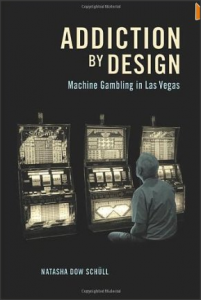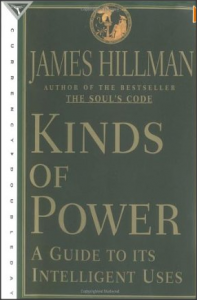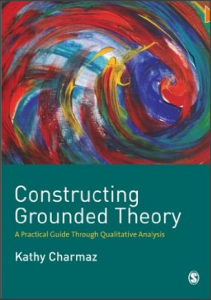I was looking for a particular book the other day on the Amazon website and cam across a book called Addiction by Design, Machine Gambling in Las Vegas by Natasha Dow Schüll. Schüll is associate professor in the Program in Science, Technology and Society at the Massachusetts Institute of Technology (MIT). The book concerns the recent and dramatic shift away from social forms of gambling played around roulette wheels and card tables to solitary gambling at electronic terminals. The book draws on research by Bruno Latour (ANT) as well as others involved with gambling research. The book is absolutely riveting! Schüll writes in a compulsive and even addictive style and almost every paragraph contains a jaw-dropping fact. Thoroughly recommended for anyone interested in ethnography or just how easy it is to manipulate people.
Monthly Archives: June 2013
Issues to investigate
I was speaking to a colleague at work the other day about Actor-Network Theory and applying it to a work-based issue. I mentioned that ANT seems to invoke quite strong emotional responses in people sometimes for example I mentioned using ANT to another colleague who responded along the lines of “you don’t want to use ANT because it’s all about power”. This person seemed quite taken aback at the thought I would actually use ANT. This other colleague of mine said “of course ANT is about power!” I said I thought everything especially at work and in terms of project teams, innovation and technology is about power. This person recommended that I read a book called Kinds of Power by James Hillman (Doubleday, 1995).
I’ve now got a copy of this book and have just started to read it. I’ll update on this in a later post, but the main thrust of the book is that business is the one factor that impacts on everyone’s life, more than religion, government, politics, etc. Hillman asks the question “What constitutes the power of business?” Related to this is Karl Weick’s Sensemaking and his views on how power shifts in groups depending on circumstances. Anyway, as I said more on this later…
After thinking through issues relating to the last two assignment essays, reading a lot of journal papers, reading a lot of related books and thinking through work based issues that could be used as possible areas for the research component I have identified a couple of possibilities.
Three issues have the level of complexity, organisational cross-dimensionality, levels of power structure, mess and opportunity for using a range of methods such as interviews, text analysis, video and images. There are issues in all three relating to the initial concept, the business case (quality of), budgets, contractor selection (tendering processes), project team selection and management, team dynamics and in ANT terms, Problematization, obligatory passage point (s a contact point to connect all the actors those involved in the network, Punctualization (blackboxing), Translation (making connections and relating things that were previously different – relating things in a socio-technical network – how ideas are turned into concrete thing like labs, or systems etc.), the Obligatory Passage Point, Network organization, power dynamics and the breakdown of network structures, user impact, acceptance and adoption and dissolution or degeneration into failure. All three of the potential projects contains heterogeneous elements that can be blackboxed or Punctualized.
What has become clear over time though are the potential ethical, operational and governance issues. For example, there are issues about confidentiality to consider. The three potential projects are all current, live projects that have a high degree of visibility in the university. There are likely to be political and management sensitivities surrounding all three. I believe this to be the greatest difficulty in carrying out a work-based project i.e. would the institution like to potentially have problems exposed to a wider audience and have thesis published on them? I foresee some difficulties here.
Sensemaking, Grounded Theory and ANT
For the literature review for assignment two, I have been reading a range of journal papers and conference proceedings about Sensemaking, Grounded Theory and Actor-Network Theory. After reading the paper Ecological Sensemaking by Gail Whiteman and William Cooper (Academy of Management Journal, 2011), I came across a reference to the book Constructing Grounded Theory: A Practical Guide to through Qualitative Analysis by Kathy Charmaz (SAGE, 2008).
I have been reading through this book and it is an excellent introduction and guide to GT. It has given me some ideas for how GT and ANT could be combined, in fact I have a couple of papers that demonstrate how this can be done for example, the paper Actor-Network-Network Inspired Design Research: Methodology and Reflections (Ben Krall, 2007) and Doing Chinese Studies at the Crossroads of Grounded Theory and Actor-Network Theory (Basile Zimmerman (University of Geneva, Switzerland, 2008).
For the essay for assignment two, if I had more time and more words or I had the opportunity to write it again (!), or I can just write here on this blog, I would re-focus on the combining of GT and ANT. I believe that GT can provide a structured framework for the application of ANT. GT and ANT are complimentary in terms of the methods used i.e. structured intensive interviews, observation of phenomena, textual analysis, video and image analysis and coding of results. ANT on the other hand often uses the same methods, interviews, textual and document analysis and observation of phenomena. GT uses the process of writing regular memo’s to record outcomes of interviews etc.
I am also interested in Karl Weick’s Sensmaking as a possible overarching theory for my thesis. Within Sensemaking I would use Grounded Theory combined with ANT to drill into the issue. Sensemaking and organizational storytelling also have a strong relationship.
User acceptance and adoption (2)
In my previous post (https://yellowbag.edublogs.org/2013/05/28/user-acceptance-and-adoption/) I mentioned that there is scope to use case studies and / or Action Research in a work based project. Since then I have been re-reading some texts on Sensemaking – Sensemaking in Organizations, Karl Weick, 1995, for example, among others. I have come to the conclusion that Sensemaking is a good fit for my potential examination of user acceptance and adoption. There are a number of papers using Sensemaking in a technology implementation for example ‘Technology features as triggers for sensemaking’ by Terri L Griffith (Washington University, Academy ol Mcmagenient Review, 1999, Vol. 24. No. 3. 472-188.)
Abstract: Technology implementation is complex and often unpredictable. Although previous research describes mechanisms related to the social construction of technology and technology use in organizations, researchers have focused little on the inputs to these models. In this article I attempt to fill this void by examining triggers for initial user sensemaking. The prediction of sensemaking should enhance the application of theories, such as adaptive structuration, and inform the management of technology through greater anticipation of user understanding.
There is also a close link between Sensemaking and Rogers (2005) Diffusion of Innovations Theory. Very, very exciting!



